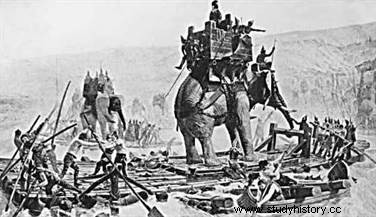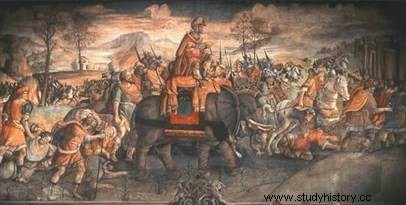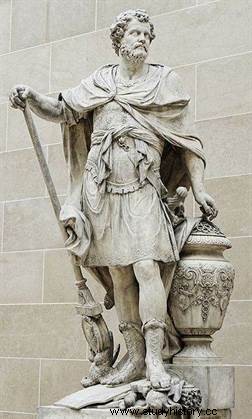 In the context of the Second Punic War, the bloody Battle of Cannes ( August 2, 216 BC) opposed a Roman army to that of Hannibal, near ancient Cannae (Apulia). In the summer of 216 BC. J.-C., the troops of the Carthaginian general, after having crossed the Alps, establish their camp close to Cannes, on the edges of Aufidus. The Roman army of the consuls Paul Émile and Varron seeks to annihilate them, but the battle, very violent, turns to the advantage of the Carthaginians. Terrible defeat for the numerically superior Roman army, this battle consecrated the Carthaginian general Hannibal among the greatest military strategists, his tactics still being taught in some military schools.
In the context of the Second Punic War, the bloody Battle of Cannes ( August 2, 216 BC) opposed a Roman army to that of Hannibal, near ancient Cannae (Apulia). In the summer of 216 BC. J.-C., the troops of the Carthaginian general, after having crossed the Alps, establish their camp close to Cannes, on the edges of Aufidus. The Roman army of the consuls Paul Émile and Varron seeks to annihilate them, but the battle, very violent, turns to the advantage of the Carthaginians. Terrible defeat for the numerically superior Roman army, this battle consecrated the Carthaginian general Hannibal among the greatest military strategists, his tactics still being taught in some military schools.
Towards the pass of four
In -218, Hannibal took the path of arms, crossing Spain, southern Gaul and then crossing the Alps, he poured his armies into Italy. Surprising the Romans in the Po plain, he successively triumphed in the battles of Ticino and Trebia and joined the Celtic populations who had just been subjugated by Rome. In -217, without waiting for the end of winter, he did it again and ambushed his opponents. Using the terrain and climate to his advantage during the Battle of Lake Trasimeno, he crushed the Roman army.
 The toll is very heavy for Rome at the end of these three confrontations:more than 30,000 dead citizens and prestige at half mast with its allies. Opposite, Hannibal presents himself as the new Alexander. A great military tactician, he also played on the political chessboard, promising to bring "freedom" to the Italian cities under the Roman yoke. Rome subsequently adopted a tactic of "delaying", avoiding frontal clashes and constantly harassing the Punic army in a war of attrition. She nevertheless decides to put an end to Hannibal's actions, which were then ravaging Apulia, Samnium and Campania.
The toll is very heavy for Rome at the end of these three confrontations:more than 30,000 dead citizens and prestige at half mast with its allies. Opposite, Hannibal presents himself as the new Alexander. A great military tactician, he also played on the political chessboard, promising to bring "freedom" to the Italian cities under the Roman yoke. Rome subsequently adopted a tactic of "delaying", avoiding frontal clashes and constantly harassing the Punic army in a war of attrition. She nevertheless decides to put an end to Hannibal's actions, which were then ravaging Apulia, Samnium and Campania.
In -216, two new consuls took charge, Lucius Aemilius Paulus known as Paul Émile who preferred to pursue a tactic of harassment and exhaustion of African troops and Caius Terentius Varro, says Varro who, on the contrary, seeks direct confrontation while the plebs are beginning to tire of conflict. No less than eight legions, "staff never reached" according to the Greek historian Polybius, are aligned to face the Punics. Combined with its Italian allies, the Roman army had nearly 80,000 men. For his part, continuing his looting in the south-east of Italy, Hannibal, whose army hardly numbers more than 50,000 men, seizes warehouses of wheat intended for the Roman army located in a small city of Apulia, Cannes, today named Canne della Battaglia .
The Battle of Cannes or the heyday of Hannibal
The decisive encounter between the two armies takes place from August 2 -216. Varro then commands the Roman army (each of the consuls taking command every other day) and makes it adopt one of the most classic forms. Taking the left wing with the cavalry of the allies, Varro entrusted the right wing to Paul Émile. At the level of the infantry in the center, no strategic novelty is adopted:the most trained Roman legions form the hard core with on the flanks, the allied legions on both sides.
 Hannibal put in place a most audacious strategy, characteristic according to Yvan Le Bohec of "his will to wage a battle of encirclement and annihilation". In the center, facing the Roman legions, he positioned the Gallic infantry, flanked on either side by the African heavy infantry, his elite whom he personally commanded. On the wings is the cavalry, the Iberians and Gauls commanded by Hasdrubal on the left and the Numidians commanded by Hanno on the right.
Hannibal put in place a most audacious strategy, characteristic according to Yvan Le Bohec of "his will to wage a battle of encirclement and annihilation". In the center, facing the Roman legions, he positioned the Gallic infantry, flanked on either side by the African heavy infantry, his elite whom he personally commanded. On the wings is the cavalry, the Iberians and Gauls commanded by Hasdrubal on the left and the Numidians commanded by Hanno on the right.
The Carthaginian general's tactic is to advance his center (the Gallic infantry), quickly repulsed by the Romans who rush to attack. On the wings, the cavalry battles quickly turned to the advantage of the Punics. Hasbrubal reduced the Roman horsemen to nothing and came to reinforce Hanno, pushing back the cavalry of the Italian allies then taken from the rear. It is then too late for the Roman infantry who sees the noose gradually closing in on them, when they believed victory was within reach. Indeed, if the Gauls in the center retreated, they did not yield, thus allowing the Punic heavy infantry by conversion to gradually surround them on the left and the right while the horsemen, rid of their Italic vis-à-vis cut any possible retreat and completely close the trap. The encirclement is perfect and the rest of the Battle of Cannes is nothing but massacre.
Canes, mortuary field of the Roman army
One of the greatest armies ever assembled by Rome is annihilated on the battlefield. If the sources differ on the number of survivors, it is generally accepted that the losses amounted to 45,000 dead and 20,000 prisoners for the Roman army, only 15,000 men managed to escape. Worse still, the bloodletting affects the high Roman magistrates and senators, many military tribunes, former consuls, lenders or quaestors are among the victims, as is Paul Émile. Varro, he was able to escape just like a young soldier, Scipio not yet named the African and who as a good student was soon to surpass the master. Opposite, triumphant Hannibal lost less than 6,000 men, the majority of whom were Gallic, an undisciplined and unreliable force for him.
After Cannes, Rome seems to be on the verge of disaster, at the mercy of Carthage in what is one of the most difficult wars in its history. However, Hannibal does not give him the coup de grace, which one of his seconds reproached him according to Livy:"You know how to win, Hannibal, but you do not know how to exploit your victory". Even if Rome would also have had to recognize its defeat, it took political and military measures on the contrary. Losing a battle does not mean losing the war.
Biography
- LE BOHEC, Yann, Military History of the Punic Wars, Editions du Rocher, Collection The Art of War, 1996.
- The Battle of Cannes and its Ghosts, by Robert L. O'Connell. Laville Editions, 2012.
- LANCEL, Serge, Hannibal, Editions Fayard, Paris, 1995.
